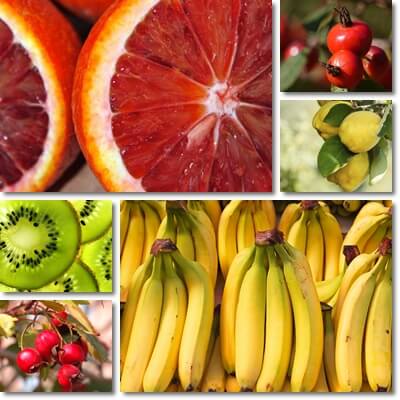What fruits to eat this winter that are also healthy and a pleasant change from all the hot cocoa and marshmallows, pie and other festive desserts? If we were to compile a healthy winter fruits list, we’d realize there are a lot of options.
You have the obvious choice, which is oranges, and all the orange variants – clementines, tangerines, mandarins and more -, but also kiwifruit, bananas, lychee or litchi, sapodilla, quinces, but also rose hip berries.
Each of these fruits is a varied source of nutrition, rich in specific vitamins and minerals that both boost nutrition and provide a series of wonderful health benefits. So if you’re at a loss when it comes to healthy winter fruits, this list below will tell you what fruits to eat this winter that are both healthy and nutritious and why eat them.
1-Rose hip
Rose hip berries make an excellent winter fruit to eat raw, cooked or add to tea. While not the most palatable, wild rose hip berries are one of the healthiest and most nutritious options to include in your winter fruits list. A serving of 100 g of fresh rose hip berries harvested from the wild provides anywhere from 300 mg of vitamin C to up to 1.3 g (the average adult requires 90 mg of vitamin C a day). The berries are rich in antioxidants, notable carotenes and xanthophylls such as beta-carotene, alpha-carotene, lycopene, beta-cryptoxanthin, lutein, zeaxanthin. Some of these antioxidant have vitamin A activity, making rose hip berries good for eyesight as well as immunity. Eating raw rose hip berries sourced from the wild provides benefits for arthritis and can help relieve pain associated with the condition.

2-Kiwifruit
Also known as the Chinese gooseberry, the green kiwifruit or green kiwi (Actinidia deliciosa) is one of the best winter fruits to eat on our list. It’s ripe and ready to harvest in November in the Northern hemisphere, making it a seasonal fruit. Not only this, but the kiwifruit provides good nutrition, with over 100% of the recommended daily intake of vitamin C per 100 g.
Which means that eating kiwifruit is good for the immune system, especially now during winter when the common cold, flu and other respiratory infections are prevalent.
Moreover, it helps in the production of collagen to maintain skin elasticity and helps keep gums and teeth healthy. Other kiwifruit benefits include lowering blood pressure thanks to a good potassium content (over 300 mg per 100 g) and no sodium.
One of the most interesting facts about kiwifruit is that it contains a protein-digesting and meat-tenderizing enzyme called actinidain that can aid digestion and therefore makes it a good fruit to eat after a festive meal consisting of turkey, duck or pork because it helps you digest meat faster. But do you eat kiwifruit skin? Yes, if you’d like to. Eating kiwifruit with skin can actually prove more nutritious because of the extra fiber and vitamins you get from the skin. If you do eat the skin of a kiwi, make sure the fruit is from organic agriculture. If you simply don’t like the fuzzy texture, just peel it. For best nutrition, the kiwifruit is best eaten raw.
3-Lychee
Australian lychees or litchis are in season starting November and up until late January, meaning you are likely to find them in your supermarket this December. Lychee makes our healthy winter fruits list not only because it’s in season right now, but also because it’s a great source of vitamin C. A serving of 100 g of lychee has over 70 mg of vitamin C, more than oranges (oranges have between 45 mg and 53 mg of vitamin C per 100 g). If you are looking to get more vitamin C this winter, but want to avoid oranges because they’re acidic and upset your gastritis, for example, then lychee fruit make a great substitute. While lychee nutrition isn’t at all spectacular, it’s a good fruit to eat for healthy gums and teeth, clear skin, less wrinkles and better immunity. In addition to these wonderful health benefits, the fruit is a good source of antioxidants, but should only be eaten ripe.

4-Quinces
What is a quince? Quinces are large, bulky-looking fruits, bright-yellow when ripe, with a strong, especially pleasant odor and a tough, dense, slightly gritty flesh with astringent properties and a tart taste. Its scientific name is Cydonia oblonga and it belongs to the Rosaceae family, meaning the quince is related to apples, pears, medlars, loquats, but also hawthorn and Amelanchier or serviceberries (see benefits of Amelanchier, serviceberry). In the Northern hemisphere, quinces start ripening in October and throughout November, but should be left on the tree to be softened by frost, a process known as bletting.
The frost makes the quince flesh softer, raises the sugar content and reduces tartness, making the fruit more palatable raw. If it’s picked before the first frosts hits, the quince will retain its astringency and dry out the mouth when you eat it raw, producing a mouth-puckering sensation similar to sapodilla.
Quinces make our healthy winter fruits list not because they’re the most nutritious, but because they’re a seasonal fruit. And it’s always a good idea to eat what’s in season.
The most notable nutrition facts of quinces are a good vitamin C content (15% of recommended intake per 100 g of fruit), a good dietary fiber content (close to 2 g per 100 g) and a modest potassium content, but zero sodium.
Quinces hold benefits for the immune system and are good for the skin thanks to their vitamin C content. They boost iron absorption for higher energy levels and more vitality and are a good food to eat for high blood pressure and even digestive conditions such as gastritis.
5-Sapodilla
Sapodilla, naseberry or sapota is from the same family as the quince, but looks more like a shaved kiwifruit or a smoother potato. The ripe fruit is sweet-tasting, juicy, with malty flavors, overall fairly pleasant to eat. The dry mouth sensation when eating sapodilla is caused by tart or astringent saponins present in the unripe fruit.
The fruit is in season from September to December and a great option for a winter fruit, perfect for low-calorie desserts and as ice cream toppings. Its nutrition value is fairly similar to that of the quince.
The fruit is an especially good source of vitamin C, providing between 15% and 50% of the recommended daily intake for an average adult, and a good source of dietary fiber, iron and vitamin B5.
Sapodilla has anti-inflammatory, antioxidant, antibacterial and cholesterol-lowering properties, helps relieve constipation and boosts iron absorption, but also holds benefits for the skin and immune system. However, only the flesh is eaten; the seeds and peel should be discarded.
6-Bananas
Bananas may be available all year long, but they make a great winter fruit. Ripe bananas have a good nutritional value, being especially rich in vitamin B6 and a good source of vitamins B2, B5 and B9, vitamin C, manganese, magnesium and potassium. Thanks to their good vitamin B6 content, bananas help synthesize hemoglobin for more vitality and higher energy levels.
Eating bananas helps the body produce more vitamin B3, contributes to lower LDL cholesterol and combats tiredness and fatigue. Bananas are good for both men and women, but especially good for pregnant women due to their vitamin B9 content. Other meaningful health benefits include lowering blood pressure and benefits for the skin and immune system.
There are about 90 kcal in 100 g of banana, the equivalent of a small banana, about the same energetic value as quinces, Chinese quinces or sapodilla. The only way bananas are bad for you is if you eat them unripe – green bananas can cause digestive upset with bloating, cramps, flatulence and indigestion. See why are unripe bananas bad for you.
7-Oranges
Last on the healthy winter fruits list are oranges, also called sweet oranges. What other fruits to eat that are both healthy and festive? You can choose between the different types of sweet oranges and still get good nutrition and enjoy a range of health benefits, with minimal side effects. Valencia oranges are bright orange, sweet and mildly acidic, but juicy, with a content of 48.5 mg of vitamin C per 100 g. Navel oranges are meatier and also slightly more bitter, easier to peel, but nonetheless similarly nutritious with 59 mg of vitamin C per 100 g. The blood orange with its dark red color is rich in anthocyanin antioxidants with strong anti-inflammatory and free radical scavenging properties, but similar nutrition.
Acidless oranges have little to no organic acids, making them a good choice for anyone who can’t eat acidic foods. Clementines, tangerines and mandarins, are all hybrids between the sweet orange and the original citrus, the mandarin orange: they are a lot easier to peel, with less pith (the white, spongy tissue between the peel and pulp segments), a lot juicer and sweeter, but also far less acidic than your ordinary sweet orange. Whichever variety you may like, you are choosing a healthy fruit to eat, a fruit that’s good for your teeth and skin, boosts immunity, ups iron absorption, lowers blood pressure and cholesterol and provides antioxidant and anti-inflammatory benefits.
